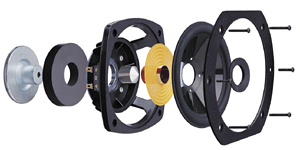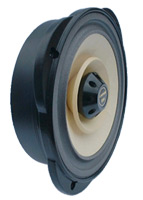 |
||
| November 15, 2002 Sound and Music: Loudspeaker Drive Units The first two features in this series addressed some fundamental questions like: "What is sound?" and "How is it created?" They discussed the way musical instruments make sound by creating vibrations in the air molecules, and how a microphone picks up these vibrations and converts them into an electrical "model" (or analog) of the sound-pressure changes that represent the music.This "model" of the music may be "stored" in either analog or digital forms on various different analog and digital media -- mechanically (vinyl, analog), magnetically (tape, analog or digital), or optically (CD, digital), to name the most obvious. Alternatively, it can be transmitted as a radio or TV signal, again in analog or digital form. To reproduce the music, the procedures are reversed, converting back from digital to analog where necessary before feeding an amplifier that supplies the power to drive the loudspeakers. Like the microphone (and for that matter the pickup or phono cartridge), the loudspeaker is known as a transducer. In this case, it changes electrical energy back into the mechanical-vibrational energy that (supposedly) regenerates the original sound in the air molecules. However, as the old saying goes, there’s many a slip ‘twixt cup and lip, and there’s plenty of opportunity for both amplifier and speakers to lose some of the precious information that the microphone has captured. Indeed, the ability to recapture and reconstitute the most delicate and subtle of musical nuances distinguishes genuine high-fidelity equipment from the more prosaic audio variety. Although there are some interesting alternatives, especially as one moves up towards the ultra-audio end of the market, the vast majority of loudspeakers comprise moving-coil drive units mounted in some sort of enclosure. The drive units themselves consist of a motor connected to a diaphragm. The motor responds to the amplifier, and the diaphragm sets up the sound vibrations in its adjacent air molecules.
The motor arrangement consists of a lightweight voice coil of wire held within a powerful magnetic gap. When electrical current (from the amplifier) passes through the coil, the charged electrons react with the magnetic field according to Fleming’s Law, creating fore-and-aft movement of coil and hence diaphragm. The same basic principle operates conventional electric motors, only they need extra gubbins (commutators and so on) to create continuous rotational motion, whereas the speaker drive unit only needs to move back and forth. The drive unit might be simpler in one way, because it only has to create to-and-fro vibrational motion. But it has other problems to contend with because of the enormous range of vibration rates it needs to cover -- from 20 per second for the deepest audible bass up to 20,000 per second at the extreme top end of the human hearing range. Creating a drive unit capable of handling the extremes at both ends of that total spectrum is very difficult indeed, so nearly all speakers use at least two drive units, and some use three or more. Which is not to say that the single full-range driver approach doesn’t have its own particular strengths. The oldest drive-unit types still in production today are unquestionably Lowther’s full-range PM types, which were born in the very earliest days of hi-fi, way back in the 1940s. (The PM initials actually stand for "permanent magnet," recalling the fact that, prior to their introduction, it was necessary to use electromagnets, with all the attendant inconvenience of needing additional external power supplies and generating heat!) From a 21st-century perspective these Lowther devices are decidedly unusual, and a long way different from the current norm. But the fact that they still exist, and have actually been enjoying something of a revival in recent years, attests to their continued relevance today. They may be way off the mainstream, and indeed to some extent reflect their historic context, but the approach has unique qualities that have created an enthusiastic and loyal following -- and spawned a number of recent imitators too. Examining their strengths and weaknesses actually provides valuable lessons on how and why today’s loudspeakers have evolved. There are two key bonuses with a Lowther driver. First, because a single driver covers the entire audio spectrum (more or less), the whole amplifier signal is fed to just the single voice coil, avoiding both the electrical and acoustical problems of trying to integrate more than one drive unit. Second -- and this is where the historical bit comes in -- all the engineering is oriented towards achieving maximum electrical-to-acoustical energy conversion efficiency. This might not seem too important today, when even relatively humble amplifiers promise 100Wpc, but when those Lowthers first appeared everything was in mono and the typical amplifier had only around 3W to play with.
A Lowther driver therefore uses an immensely powerful magnet, a very lightweight paper (twin) cone, and a short voice coil that exactly fits the length of the magnetic gap. In order to make sure the coil stays within the gap at all times, horn loading is mandatory, and this also improves the efficiency. The end result is that a Lowther horn speaker system registers a sensitivity of around 105dB/W, against a marketplace average of around 89dB/W. That’s an enormous differential, the consequence being that a 10W amp driving a Lowther, believe it or not, is comparable to using a 300W amp with a typical mainstream loudspeaker! The important corollary, of course, is that a Lowther will give the driving amplifier a much easier time than more conventional loudspeakers. Although there are obvious positives in the unquestionably extreme Lowther approach, there are several equally obvious disadvantages. The bottom line here is that no single-driver system can do a good job of reproducing the extreme top and bottom of the frequency range, and will always progressively "beam" high frequencies, ensuring that the direct/reflected ratio will vary with frequency. The quest for high efficiency leads to significant unevenness and coloration in between, and horn speakers have to be physically very large to reach even down to 50Hz, never mind 20Hz. What’s interesting is the way these pluses and minuses are directly reflected in the listening experience. A Lowther-driven horn speaker system is an extreme example of the hi-fi speaker, and gives an extreme experience. It has brilliant coherence, marvellously realistic midband dynamics, and wonderfully subtle instrumental textures, especially at low levels. But you have to learn to live with the lack of extreme top and bottom, quite obvious coloration, and some lack of smoothness. For some people -- especially those who like low-powered valve amps of the single-ended triode variety -- this will be the sound to die for, and nothing else comes remotely close. Others wouldn’t even give such a speaker room in the house. It all depends on your personal taste and priorities, so next month I’ll look at what is likely to happen if you opt for something a little less far-out. ...Paul Messenger
Ultra Audio is part of the SoundStage! Network. |

